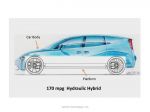
Conventional cars have powerful drivetrains for fast acceleration and brakes to stop the car. They are heavy, costly, space consuming and waste a lot of energy. Only 1/6 of the energy is utilized to drive the vehicle.
The Hydraulic Hybrid is driven by an advanced hydrostatic drivetrain, consisting of a hydraulic free-piston engine, an accumulator and four hydraulic wheelmotors. The engine provides pressurized fluid for charging the accumulator and driving the wheelmotors. When fully charged, the engine is turned off and only fluid from the accumulator drives the car. During braking, the wheelmotors are reversed to pumps, acting as brakes, and return the entire braking energy into the accumulator. A portable electro-hydraulic module for charging can be inserted, allowing for 40 miles emission-free driving.

The 2-stroke free-piston engine with impulse charger and peripheral fuel injection has two opposed pistons, controlled by fast electro-hydraulic 2-way valves, determining the speed and compression ratio. The pistons, transferring the combustion energy directly into pressurized fluid without a crank mechanism, are free of side loads allowing for unlubricated operation and very high combustion pressure. The effects of higher temperatures are avoided by using steel components and exposing the exhaust ports only to lower gas temperatures at the end of the stroke. The impulse charger piston is driven by exhaust gas and pumps air into the combustion chamber and fluid into the accumulator. Very high combustion pressure, low heat losses, recuperation of exhaust energy, and the ultra-high pressure peripheral fuel injection reduce the fuel consumption by 30% (0.23 lb/hph) and engine weight (38 hp, 31 lbs.) drastically. (2 U.S. Patents, International patents, Patents pending)
The swashplate-type axial-piston motor has 33° infinite variable displacement, medium pressure ports, and off-center adjustment for minimizing its size and the dominating internal fluid and compression losses. The new concept increases the displacement range by 60% and turbine-like cylinder ports the flow capacity, reducing size and weight by a factor of 6. The smaller size, lower bearing loads and DLC coatings reduce frictional losses more than 50%. The greater range and lower losses multiply the usable operating range (torque, speed) by a factor of 5, providing motors for accelerating the car to maximum speed without shifting and recuperating the braking energy. (2 U.S. Patents, International patents)
The utilization of the drivetrain components as platform reduces the car weight by 50%, and the lower weight, efficient engine, and recuperation of braking energy increase the mileage to 170 mpg.
http://www.createthefuturecontest.com


















































































